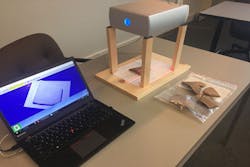Archaeologist teams up with computer vision experts for prehistoric pottery project
Researchers at the University of South Carolina are developing softwarethat automatically matches prehistoric pottery fragments with whole designs as part of a collaboration between the College of Arts and Sciences’ Center for Digital Humanities and S.C. Institute of Archaeology and Anthropology, the College of Engineering and Computing and Research Computing Center.
Funded by grants from the National Science Foundation and National Park Service, the project aims to uncover information on how people interacted and traveled in the Southeast more than 1,500 years ago. Native Americans, according to the University of South Carolina, carved designs into wooden paddles and stamped them onto pottery during a period called the Woodland period, which ran from about 100 to 900 AD. Known as "Swift Creek pottery," the fragments—called sherds or potsherds—have been found throughout southern United States, mainly in Georgia, northern Florida, parts of western South Carolina and eastern Alabama.
"Pottery paddles are like fingerprints in a way," says archaeologist Karen Smith, director of the Institute of Archaeology and Anthropology's Applied Research Division. "At the most basic level, they are indicators of individual artists. Some sherds in middle Georgia were impressed with the same paddles as sherds in Florida. That’s almost unprecedented in our field that we can see people, paddles and movement."
Swiss Creek pottery has garnered interest from archaeologists because of its prevalence in the region and the opportunity it presents to track human interaction and migration. In the 1940s, it was discovered that complete paddle designs could be reconstructed from sherds and that certain designs were widely distributed across the region. Archaeologist Bettye Broyles and naturalist Frankie Snow, in their work, reconstructed about 900 paddle designs from dozens of sites by using pattern matching techniques, but these techniques had proven to be tedious.
"We lack efficient methods for combing through the volumes of material from Swift Creek sites that reside in curation facilities across the Southeast," said Smith. "Finding sherds that match a particular known design is akin to finding a proverbial needle in a haystack."
To speed up the process, a collaboration with Colin Wilder of the Center for Digital Humanities, Song Wang, professor in the College of Engineering and Computing, and Jun Zhou of the Research Computing Center was initiated. Using digital imaging and analysis technologies, the group is developing algorithms and software that will automatically match patterns between sherds and designs.
"We are speeding up a task and making it hundreds of times faster," Wilder says. "This is a task that is tedious and difficult to do, and there are large collections of unprocessed pottery. There is a huge mystery out there. What is the actual story of these people and their movements? It’s within the realm of the possible to find out."
When it comes to machine vision, one of the most important steps in machine vision applications can be locating an object of interest within the camera’s field of view—a task that can be accomplished with pattern matching software. One of the earliest approaches of performing pattern matching is correlation; in which a template of a known good image is stepped over the captured image and a pixel-by pixel region comparison made.
Other methods include texture-based pattern matching, and using multiple templates, such as in the CVB Polimago pattern matching tool from Stemmer Imaging, which first extracts characteristics from a template that are then saved in a model. Artificial views of the template are then automatically generated at different scales, rotations and angles to reproduce various positions of the scene that may be encountered. Learn more about pattern matching software here.
This summer, Smith and her graduate students will travel to various Swift Creek pottery collections in Georgia to scan pottery sherds and begin building a database of images. Along with data processing algorithms, the team will use a 3D scanner to make matches, said Wang, whose research expertise is in computer vision and image processing.
The algorithms will extract patterns from an individual sherd, identify the underlying design, and ultimately connect it with a corresponding reconstructed whole design. Because the paddles were applied to pottery multiple times to imprint designs, this presents a challenge that Wang is eager to accomplish by developing new algorithms.
"Solving this problem will advance and extend the basic computer vision research on shape and partial shape matching, which have been studied for a long time in the computer vision field," Wang says.
Furthermore, the team utilized high-performance computer clusters to bring the processing time down from hours to minutes.
The team chose to utilize computer vision algorithms, it said, because the paddle designs are not random but rather follow certain regularities and rules.
"Through this project, we can begin to map out how creativity in this artistic system changed through time, as well as when, where and how designs were copied," Smith says.
Ultimately, the goal of the project is to create a website where archaeologists and other interested individuals can upload photos of sherds, access the pattern-matching technology and identify pieces right away, according to Wilder.
View the University of South Carolina release.
Share your vision-related news by contacting James Carroll, Senior Web Editor, Vision Systems Design
To receive news like this in your inbox, click here.
Join our LinkedIn group | Like us on Facebook | Follow us on Twitter
Learn more: search the Vision Systems Design Buyer's Guide for companies, new products, press releases, and videos
About the Author

James Carroll
Former VSD Editor James Carroll joined the team 2013. Carroll covered machine vision and imaging from numerous angles, including application stories, industry news, market updates, and new products. In addition to writing and editing articles, Carroll managed the Innovators Awards program and webcasts.
